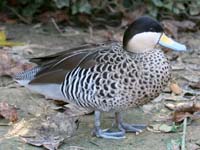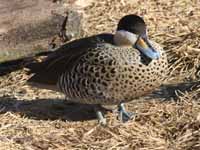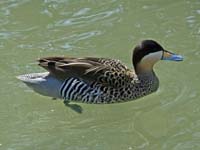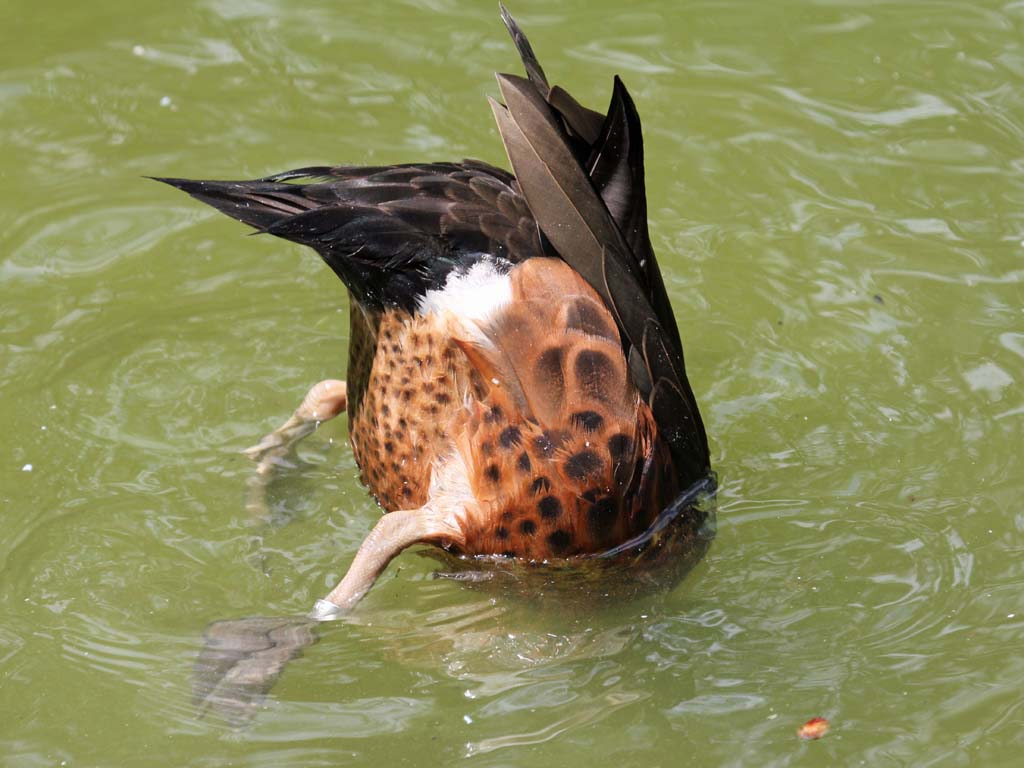The term waterfowl is used to describe any member of the order Anseriformes. A series of articles describes all the waterfowl. This specific article describes the teals which belong to family Anatidae, subfamily Anatinae.
Anseriformes
Most species of the order Anseriformes spend a considerable amount of time in water. In fact, they are called waterfowls. Their webbed feet make for efficient swimming. A few species spend little time in water and thus their feet are only partially webbed. Most waterfowl are also good flyers, many migrating long distances to escape the cold and others migrating shorter distances for optimizing their food supply. All species, except the screamers, have a wide and relatively flat bill. The shape of a species bill and also their tongue is a function of their diet. Considering the entire order, they eat aquatic plants, grasses, sedges, algae, plankton, insects, insect larvae, mollusks, crustaceans, fish, fruits, grains, rice. Most species are monogamous and if they lose a partner seem to mourn. Males are larger and heavier than females. The chicks are well developed when they hatch and can walk almost immediately.
The order Anseriformes has 3 familes: Anatidae, Anhimidae, Anseranatidae. Family Anatidae is comprised of the ducks, swans, and geese which amounts to about 160 species. Family Anhimidae is made up of 3 screamer species while family Anseranatidae has only one species, the magpie goose. Since these latter two families contain so few species, it seems appropriate to consider the entire order in this series of articles.
Anatidae
The Anatidae family has the following subfamiles:
Anatinae: dabbling ducks and teals
Anserinae: geese, swans
Aythyinae: diving ducks
Dendrocygninae: whistling ducks
Merginae: sea-ducks
Oxyurinae: stiff-tailed ducks
Plectropterinae: spur-winged goose
Stictonettinae: freckled duck
Tadorninae: shelducks, shelgeese
Teals
The members of subfamily Anatinae are refered to as dabbling ducks because they do not totally submerge when feeding and are often seen with just their rears showing as they search for food. Because of their feeding method, dabbling ducks have evolved to be more buoyant than diving ducks. The dabbling duck only rarely dives. In fact, the stiff-tailed ducks that do dive and yet have been placed in Anatinae, is placed by some (including this author) in its own sub-family.
Not all species in this subfamily have "duck" in their name. This article describes the teals. In general, it a dabbling duck has "teal" in its name, then it is smaller than the rest of the subfamily. Unfortunately, there are many exceptions to this generalization. In fact, some genera have species that are described with the teal article, and others that are described with the dabbling duck article. The genera that have their species split between the two articles are Anas and Spatula.
Speculum
The speculum is a patch on the upper surface of secondary feathers. For the mallard show below, it is the bright blue patch plus the white borders.

Image by Ykpaihcbka
Not all birds have speculums. The dabbling ducks have especially vivid speculums many of which are iridescent. The speculum is best seen while the duck is in flight; when the duck is at rest the speculum may be partially or completely hidden. Very often careful observation of a duck's speculum is sufficient to identify the species. Pay attention not to just the main color of the speculum, but also the top and bottom borders. These borders are often referred to as the "leading edge" and "trailing edge" respectively.
A duck's speculum can be considered to be its barcode. Read it carefully and you can know the species. Of course speculums did not evolve to make birders happy! They must have evolved to help ducks easily recognize kindred spirits. In the material that follows, when possible a speculum image is included for each species.
Habitat and Diet
It is not surprising that the dabbling duck subfamily preferred habitat is water. Most prefer freshwater, at least for a considerable portion of the year. Some will choose brackish or saline habitats in the winter. The purpose of dabbling is to obtain food which implies that dabbling duck prefer shallow wetlands so they can reach the bottom. The typical dabbling duck's diet is comprised of aquatic vegetables and insects, seeds, crustaceans, and mollusks. In a number of species, the juveniles often have a higher proportion of invertebrates than the more vegetarian adults.
Genus Amazonetta - 1 species
Teal, Brazilian Amazonetta brasiliensis
Description: The male Brazilian teal has a chestnut-brown back and crown with greyish white cheeks. The upper-breast is pale chestnut-brown with black spots. The lower-breast and belly are buff and the tail is black. The female is similar with a white spot at the base of the bill and white spot in front of the eye. Males have a red bill, and females have a black bill.
Range: Eastern South America.
Habitat: Freshwater with dense vegetation nearby.
Diet: Seeds, fruits, roots, and insects.
Conservation status: Least Concern.
Image by: 1) Pedro_De_Paula 2) Claudio Timm 3) John_Proctor 4) Dario Sanches - Brazil Range: Eastern South America.
Habitat: Freshwater with dense vegetation nearby.
Diet: Seeds, fruits, roots, and insects.
Conservation status: Least Concern.
1) Pair - female in fore-ground 2) Female 3 - 4) Male
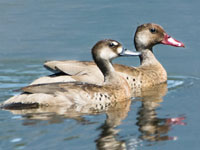
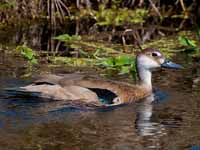
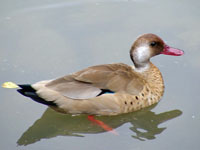
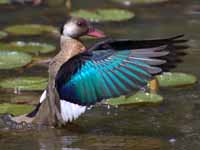
Genus Anas
This genus is the prototype for dabbling ducks. Most of the species are buoyant and will "dabble" with the head under water and the rear above water pointing skyward. Shown here are the members of Anas that are teals. There are many other members of the genus that are not called teals.
Teal,_Andaman Anas albogularis
Description: The Andaman teal has mainly dark brown plumage with buffy markings. The throat and face are pale and there is a white eye-ring. Its speculum is mainly black with a broad white leading edge.
Range: Andaman Islands of India.
Habitat: Inland pools as well as mangroves and lagoons.
Diet: Aquatic insects and seeds. Forages mainly at night.
Conservation status: The Andaman teal is Vulnerable due to habitat modification, but the population seems to be increasing.
Image by: 1) John Gerrard Keulemans 2) Balaji_Venkatesh_Sivaramakrishnan Range: Andaman Islands of India.
Habitat: Inland pools as well as mangroves and lagoons.
Diet: Aquatic insects and seeds. Forages mainly at night.
Conservation status: The Andaman teal is Vulnerable due to habitat modification, but the population seems to be increasing.
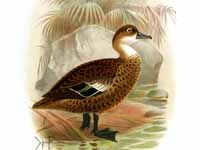
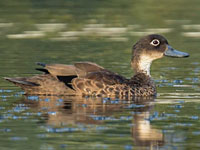
Teal,_Andean Anas andium
Description: The Andean teal dark brown upperparts with a grey head and neck. It has a black speculum with a red leading edge and a buff or white trailing edge. The underparts are grey with heavy dark markings on the breast. The bill is black and legs are grey.
Range: Andean highlands of Columbia, Ecuador, Venezuela.
Habitat: Freshwater wetlands.
Diet: Aquatic plants and insects, crustaceans.
Conservation status: Least Concern.
Image by: 1, 4) Felix_Uribe - Columbia 2) Gary_Clark - Ecuador 3) Jei_Pov Range: Andean highlands of Columbia, Ecuador, Venezuela.
Habitat: Freshwater wetlands.
Diet: Aquatic plants and insects, crustaceans.
Conservation status: Least Concern.



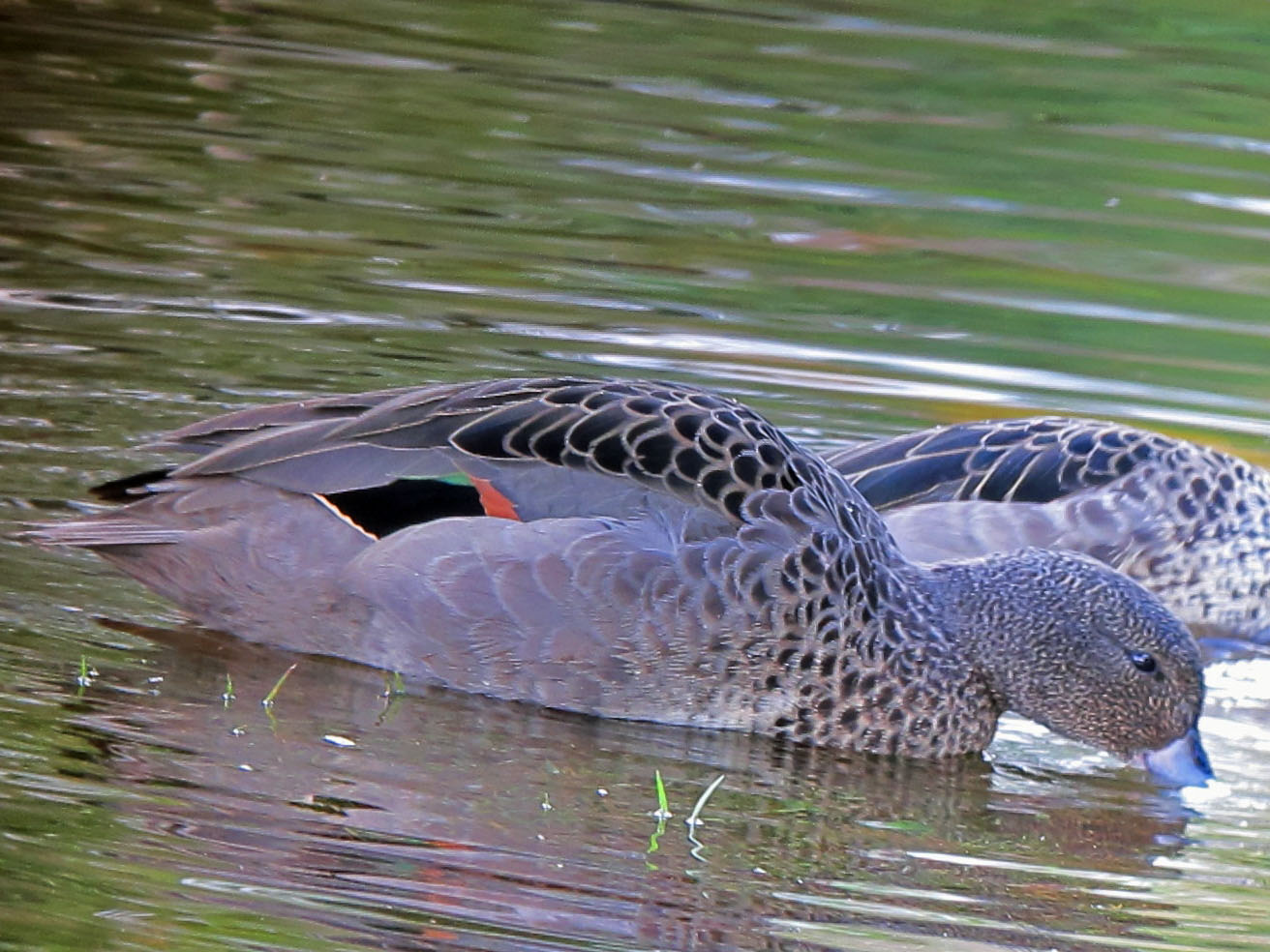
Teal, Auckland (Island) Anas aucklandica
Description: The Auckland teal has brown plumage with a hint of green on the neck. The head is green and it has a pale eye-ring. This teal is flightless.
Range: Auckland Islands (south of New Zealand).
Habitat: Shrubland, coastal waters.
Diet: Crustaceans, mollusks, algae.
Conservation status: The Auckland teal is considered Vulnerable. Because it is flightless, introduced predators can easily decimate an island's population.
Image by: 1) Kimberley_Collins 2) Austronesian Expeditions Range: Auckland Islands (south of New Zealand).
Habitat: Shrubland, coastal waters.
Diet: Crustaceans, mollusks, algae.
Conservation status: The Auckland teal is considered Vulnerable. Because it is flightless, introduced predators can easily decimate an island's population.
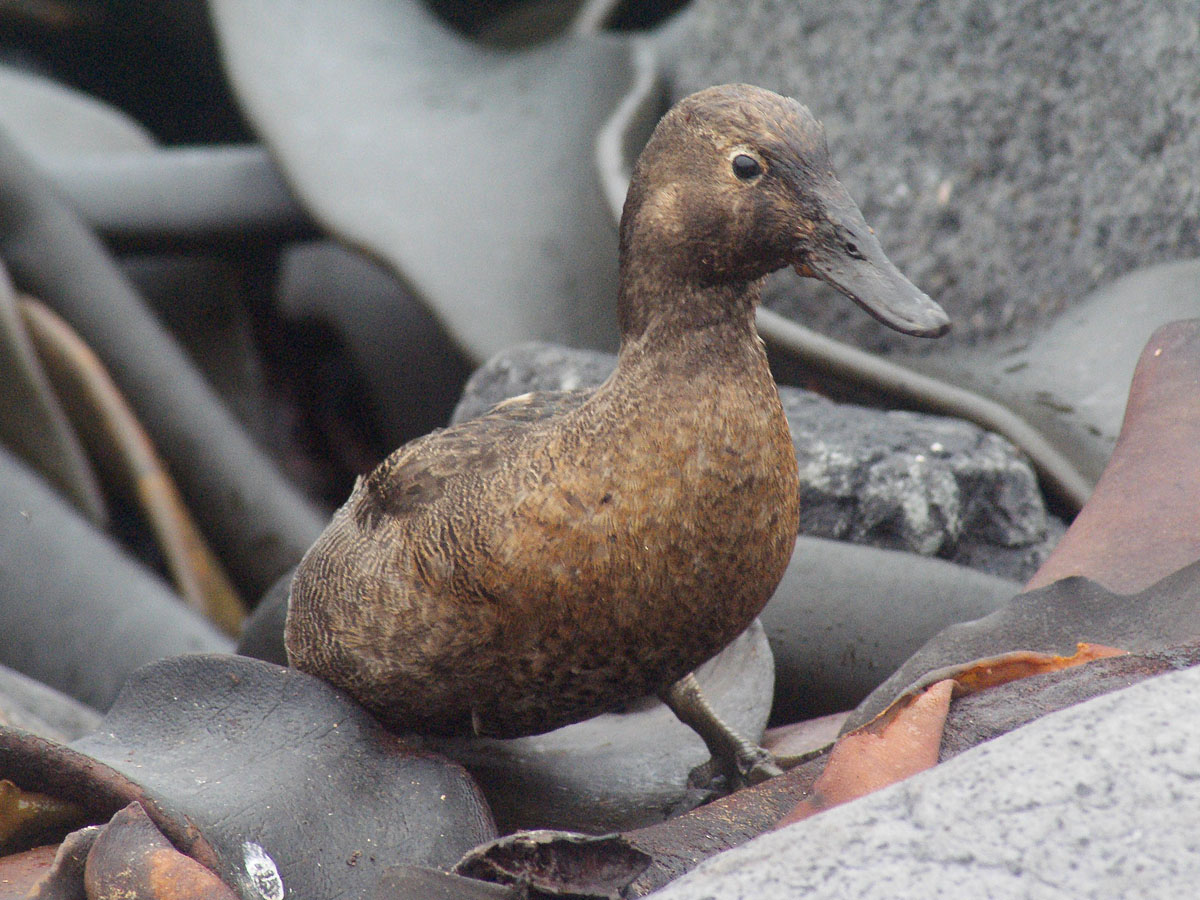
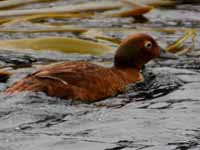
Teal,_Bernier's Anas bernieri
Description: The Bernier's teal, also known as the Madagascar teal, has a brown body with mottled flanks and breast. The light colored head is one identifying feature. Another is its black speculum with a broad white leading edge and a narrow white trailing edge.
Range: Madagascar.
Habitat: Shallow waters, fresh or saline, with above water plants such as reeds.
Diet: Mainly insects, both terrestrial and aquatic. Also seeds and plants.
Conservation status: The Bernier's teal is Endangered because of deforestation and also being hunted for food.
Image by: 1, 2, 3) Dick Daniels - Sylvan Heights 4) Dick - Antananarivo Zoo, Madagascar Range: Madagascar.
Habitat: Shallow waters, fresh or saline, with above water plants such as reeds.
Diet: Mainly insects, both terrestrial and aquatic. Also seeds and plants.
Conservation status: The Bernier's teal is Endangered because of deforestation and also being hunted for food.
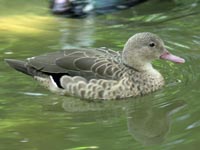
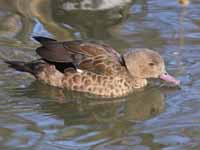
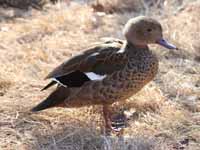

Teal,_Brown Anas chlorotis
Description: The Brown teal has brown plumage with mottling on the upperparts. There is a pale eye-ring. It has a green speculum with a buff leading edge and a white trailing edge. During breeding season the male has a green head and a chestnut breast.
Range: Islands off New Zealand.
Habitat: Freshwaters with some tree cover. Also sheltered coastal waters.
Diet: Insects, crustaceans, mollusks.
Conservation status: The brown teal is Near Threatened due to over hunting. Conservation efforts are having encouraging results.
Image by: 1) Sabine's Sunbird 2) digitaltrails 3) Bernard_Spragg 4) Diego_TiriraRange: Islands off New Zealand.
Habitat: Freshwaters with some tree cover. Also sheltered coastal waters.
Diet: Insects, crustaceans, mollusks.
Conservation status: The brown teal is Near Threatened due to over hunting. Conservation efforts are having encouraging results.
4) Breeding
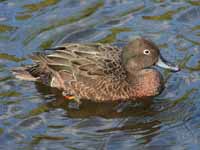
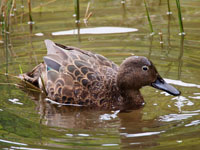
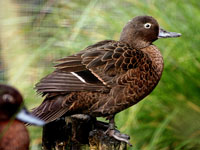
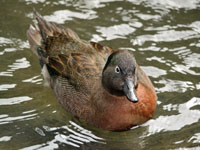
Teal,_Campbell_Island Anas nesiotis
Description: The Campell Island teal is mainly brown. The head and back are dark and tinged with iridescent green. The male has a chestnut breast. It has short wings and is flightless. It is sometimes consider conspecific with the brown teal.
Range: The Campbell Islands of New Zealand.
Habitat: Throughout most of the island and also on beaches.
Diet: Invertebrates, seaweed.
Conservation status:The Campbell Islands teal is considered Vulnerable. Because it is flightless, introduced predators can easily decimate an island's population..
Image by: 1) Dick Daniels -
Kiwi Birdlife Park, New Zealand 2) Stomac 3, 4) Jake_Osborne - Codfish Island, New ZealandRange: The Campbell Islands of New Zealand.
Habitat: Throughout most of the island and also on beaches.
Diet: Invertebrates, seaweed.
Conservation status:The Campbell Islands teal is considered Vulnerable. Because it is flightless, introduced predators can easily decimate an island's population..
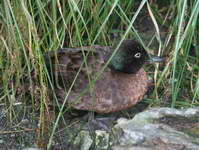
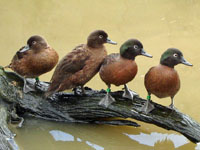
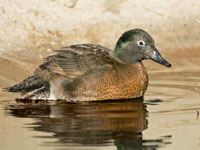
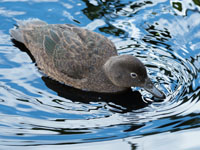
Teal,_Cape Anas capensis
Description: The Cape teal is mainly grey with a browner back and pink bill. It has a green speculum bordered by white. The underparts have dark spots, especially on the flanks.
Range: Sub-Saharan Africa.
Habitat: Open wetlands.
Diet: Aquatic plants, invertebrates, crustaceans, amphibians.
Conservation status: Least Concern.
Image by: 1, 2) Dick Daniels - Sylvan Heights 3) BS_Thurner_HofRange: Sub-Saharan Africa.
Habitat: Open wetlands.
Diet: Aquatic plants, invertebrates, crustaceans, amphibians.
Conservation status: Least Concern.
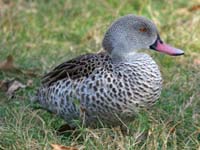
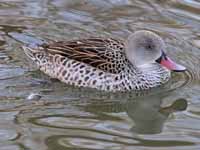
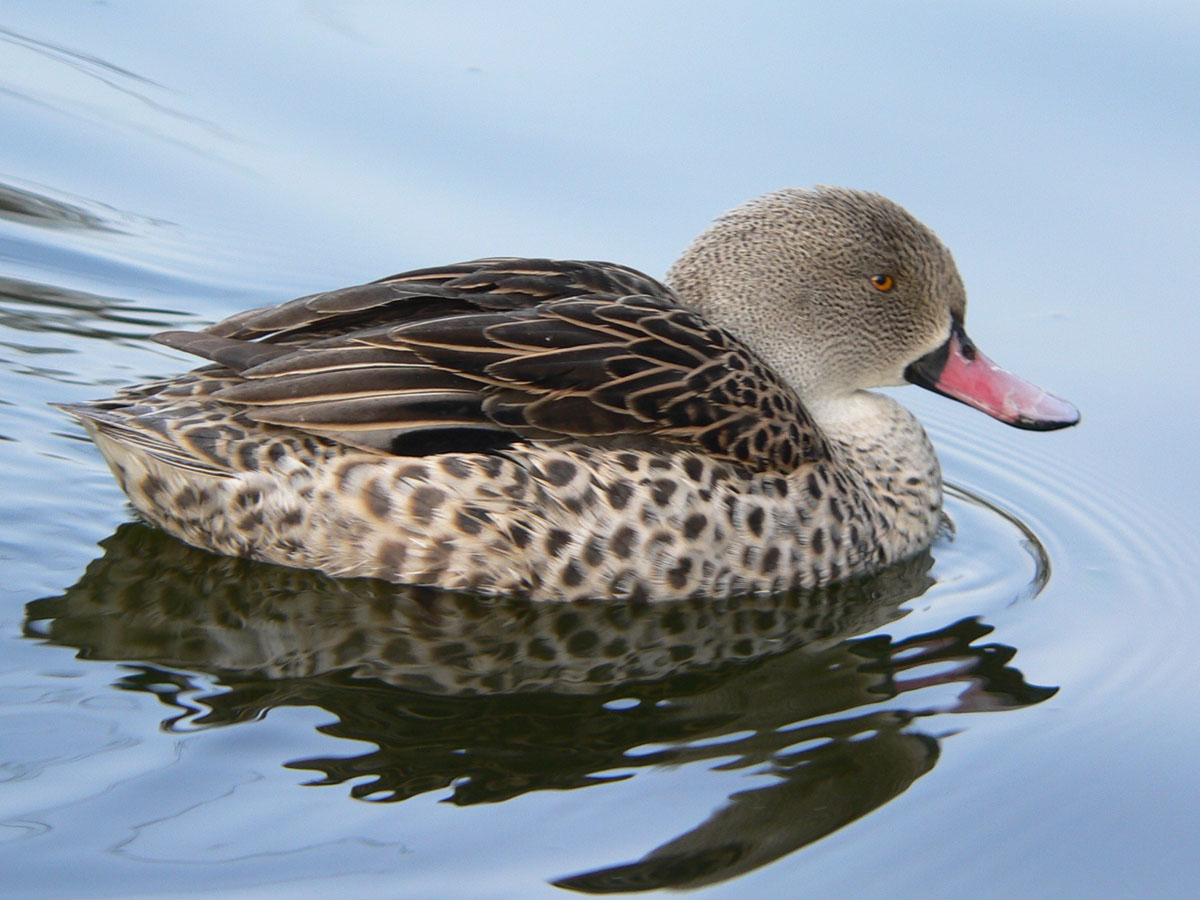
Teal,_Chestnut Anas castanea
Description: The breeding male chestnut teal has a green head, dark brown upperparts, and mottled rufous underparts. The female has a brown head and mottled brown body. Both sexes have red eyes and a blue-grey bill. Their speculum is black with a wide white leading edge. The female chestnut teal is similar to the female grey teal. The grey teal has a lighter neck and face than the Chestnut teal.
Range: Australia.
Habitat: Prefers coastal estuaries and wetlands.
Diet: It is an omnivore, liking both invertebrates and aquatic plants.
Conservation status: Least Concern.
Image by: 1, 2) Wayne Butterworth 3, 4) Dick Daniels - Sylvan Heights Range: Australia.
Habitat: Prefers coastal estuaries and wetlands.
Diet: It is an omnivore, liking both invertebrates and aquatic plants.
Conservation status: Least Concern.
1) Pair 2) Female 3 - 6) Male
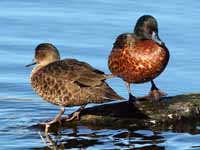
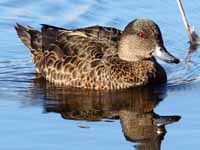
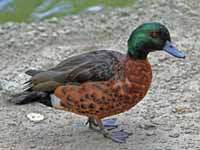
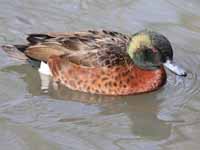
Teal,_Eurasian Anas crecca
Description: The Eurasian teal, also known as the common teal or the green-winged teal, gives its name to the blue-green color teal. It is a small dabbling duck with a dark green speculum which has a buff leading edge and white trailing edge. The breeding male has a chestnut head, green eye-patch, grey back and flanks. The female is mottled brown and has a dark eye-line. Some consider the green-winged teal of North America to be a subspecies. The breeding mail of the green-winged teal is similar the Eurasian teal, but he has a vertical white stripe on side of breast. The species are difficult to differentiate for nonbreeding males and also females. Size is the best differentiator between a female Eurasian teal and a female mallard which is larger.
Range: Europe, Asia.
Habitat: Freshwater wetlands with abundant vegetation. During winters it becomes more coastal.
Diet: Aquatic vegetation, seeds, aquatic insects, crustaceans, mollusks.
Conservation status: Least Concern.
Image by: 1, 2) Dick Daniels - Sylvan Heights 3) Imran_Shah 4) HobbyfotowikiRange: Europe, Asia.
Habitat: Freshwater wetlands with abundant vegetation. During winters it becomes more coastal.
Diet: Aquatic vegetation, seeds, aquatic insects, crustaceans, mollusks.
Conservation status: Least Concern.
1, 2) Female 3, 4) Male

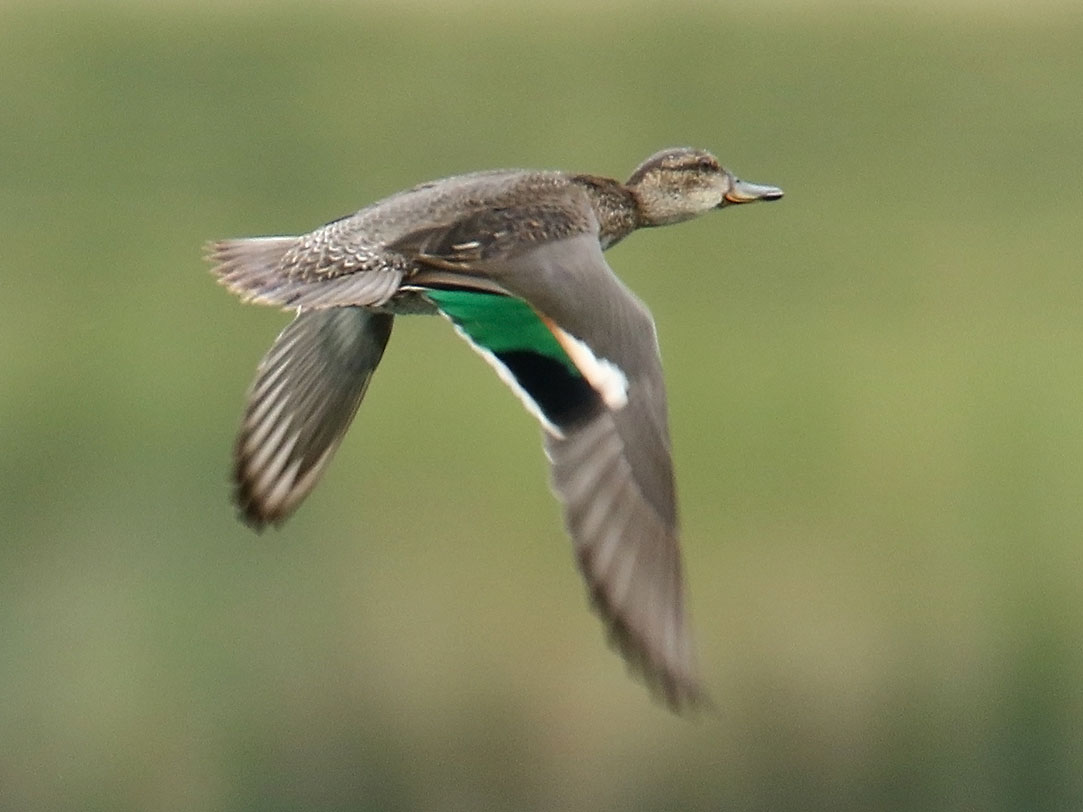
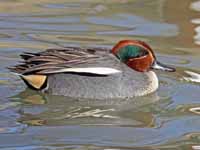

Teal,_Green-winged Anas carolinensis
Description: The green-winged teal is the smallest North American dabbling duck. It has a dark green speculum which has a buff leading edge and white trailing edge. The breeding male green-winged teal has a chestnut head, green eye patch, grey back and flanks. The female is mottled brown and has a dark eye-line.
Range: North America.
Habitat: Sheltered wetlands such as bogs.
Diet: Aquatic vegetaton, seeds, aquatic insects, crustaceans, mollusks.
Similar to:
Blue-winged teal, Cinnamon teal. The female green-winged teal can be differentiated from these other teals by its dark eye-line.
Eurasian teal. Some consider these the same species. The breeding male green-winged teal has a vertical white stripe on side of breast, the breeding Eurasian teal does not. The species are difficult to differentiate for nonbreeding males and also females.
Mallard (female). Plumage of female green-winged teal and female mallard is similar. Size is the best differentiator.
Conservation status: Least Concern.
Image by: 1, 3, 4) Dick - Sylvan
Heights 2) Kati_Flemin - TexasRange: North America.
Habitat: Sheltered wetlands such as bogs.
Diet: Aquatic vegetaton, seeds, aquatic insects, crustaceans, mollusks.
Similar to:
Blue-winged teal, Cinnamon teal. The female green-winged teal can be differentiated from these other teals by its dark eye-line.
Eurasian teal. Some consider these the same species. The breeding male green-winged teal has a vertical white stripe on side of breast, the breeding Eurasian teal does not. The species are difficult to differentiate for nonbreeding males and also females.
Mallard (female). Plumage of female green-winged teal and female mallard is similar. Size is the best differentiator.
Conservation status: Least Concern.
1, 2) Female 3, 4) Male
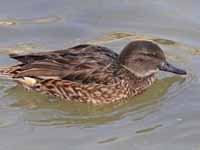
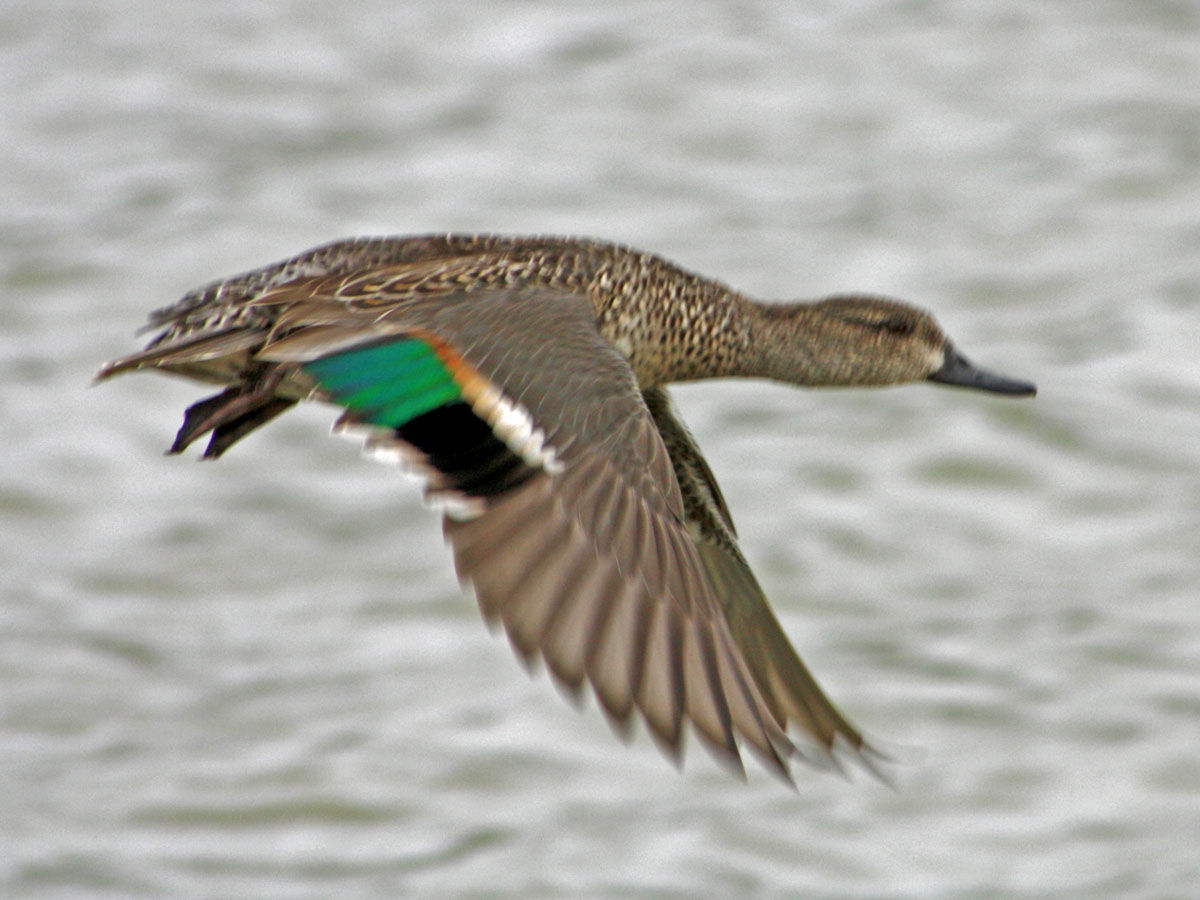
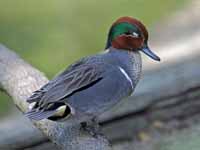
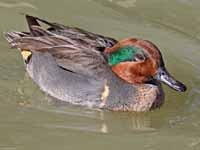
Teal,_Grey Anas gracilis
Description: The grey teal is mostly grey-brown. It has a pale chin and throat, red eye, and blue-grey bill.
The Sunda teal (Anas gibberifrons) was previously considered a subspecies. They both have a black speculum with a broad white leading edge. However, the grey teal has a lighter neck and face than the similar female chestnut teal.
Range: Australia, New Zealand, and other Pacific Islands.
Habitat: Open wetlands.
Diet: Aquatic and shoreline vegetation, aquatic insects, crustaceans, mollusks.
Conservation status: Least Concern.
Image by: 1) Oystercatcher 2) JJ Harrison - Tasmania, Australia 3) Auckland_War_Memorial_Museum - SpeculumThe Sunda teal (Anas gibberifrons) was previously considered a subspecies. They both have a black speculum with a broad white leading edge. However, the grey teal has a lighter neck and face than the similar female chestnut teal.
Range: Australia, New Zealand, and other Pacific Islands.
Habitat: Open wetlands.
Diet: Aquatic and shoreline vegetation, aquatic insects, crustaceans, mollusks.
Conservation status: Least Concern.
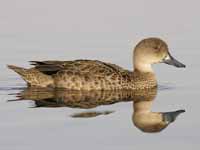
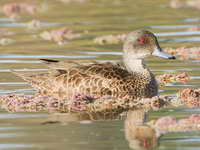
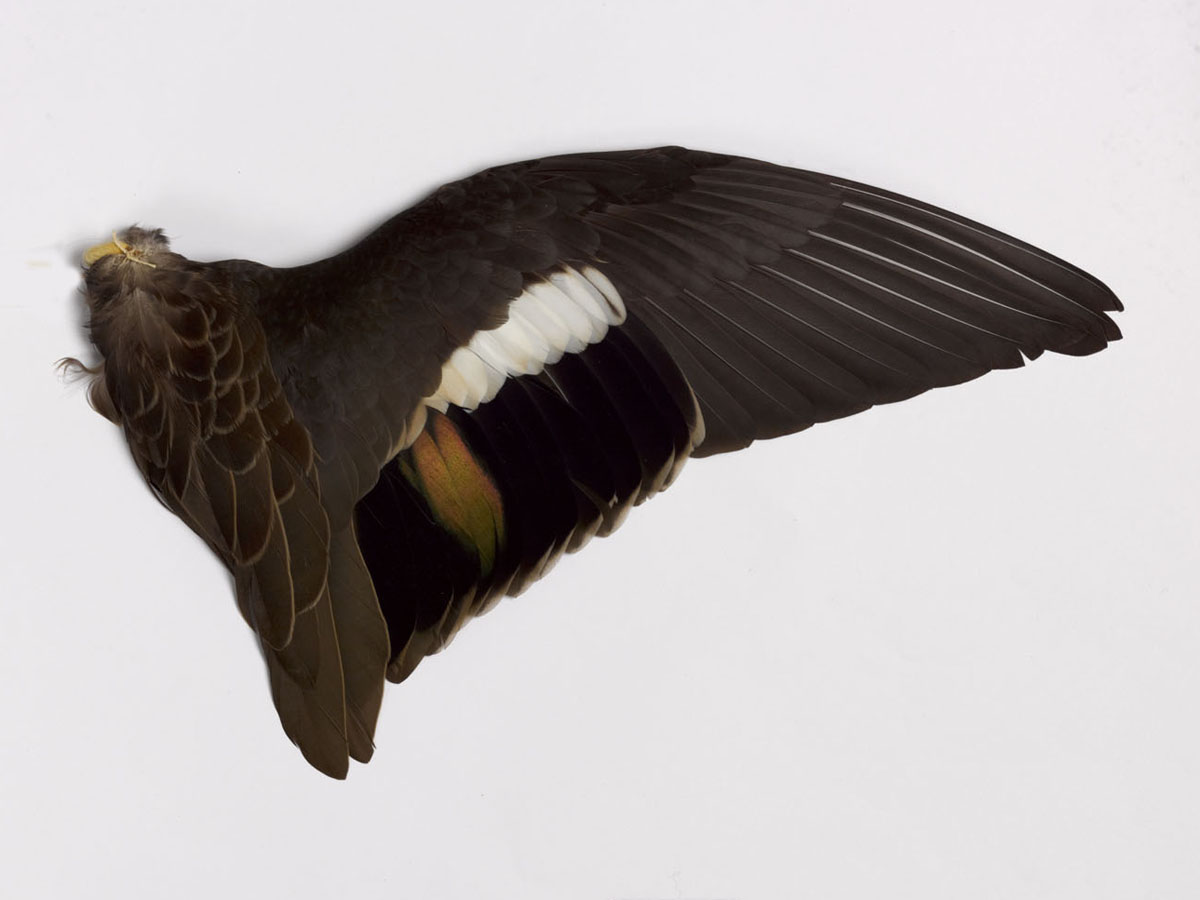
Teal,_Red-billed Anas erythrorhyncha
Description: The Red-billed teal, also known as the red-billed duck or red-billed pintail, has a red bill. It has brown upperparts, a dark head, and a brown mottled breast. It has a pale speculum with a white and black leading edge. It is similar to the Hottentot teal which has a blue bill.
Range: Africa including Madagascar.
Habitat: Freshwater wetlands in fairly open country.
Diet: Acquatic plants, grain, mollusks, aquatic insects, crustaceans.
Conservation status: Least Concern.
Image by:
1) Dick Daniels - Birds of Eden, South Africa 2) Dick Daniels - Sylvan Heights Range: Africa including Madagascar.
Habitat: Freshwater wetlands in fairly open country.
Diet: Acquatic plants, grain, mollusks, aquatic insects, crustaceans.
Conservation status: Least Concern.
3) Clint_Ralph 4) Charlie Westerinen - Hwange, Zimbabwe
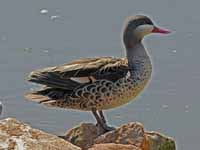
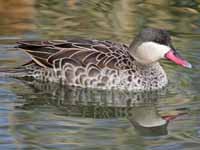
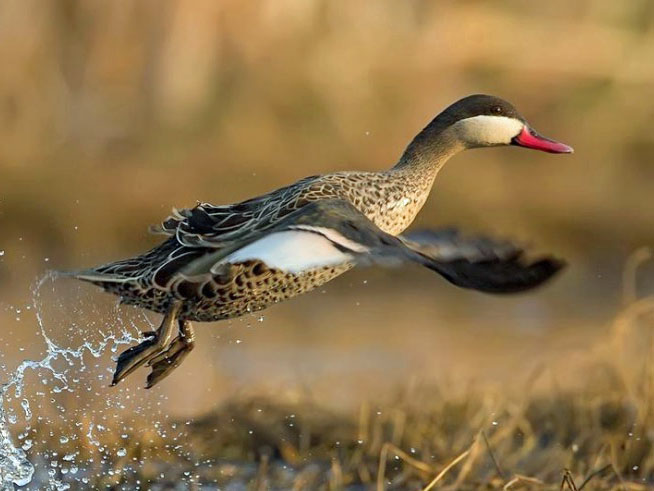
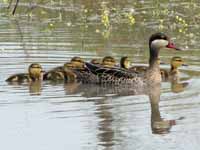
Teal,_Sunda Anas gibberifrons
Description: The Sunda teal, also known as the Indonesian teal, has mottled brown plumage. The chin and fore-neck are pale and there ia a bulging forehead. As does the Bernier's teal of Madagascar teal and the chestnut teal of Australia, the Sunda teal has a black speculum with a broad white leading edge. The female Chestnut teal is similar, but the female Sunda teal has a lighter chin and foreneck; plus their ranges do not overlap.
Range: Indonesia.
Habitat: Freshwater, saline, and brackish wetlands.
Diet: Aquatic and shoreline vegetation, aquatic insects, crustaceans, mollusks.
Conservation status: The Sunda teal is Near Threatened as it is widely hunted plus there is deforestation of its habitat.
Image by: 1) Gilfedder - Bali, Indonesia 2) curatrok77 3) Dick Daniels - Sylvan HeightsRange: Indonesia.
Habitat: Freshwater, saline, and brackish wetlands.
Diet: Aquatic and shoreline vegetation, aquatic insects, crustaceans, mollusks.
Conservation status: The Sunda teal is Near Threatened as it is widely hunted plus there is deforestation of its habitat.
3) Male
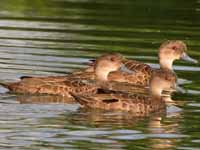
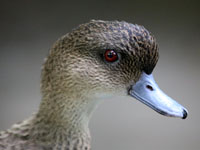
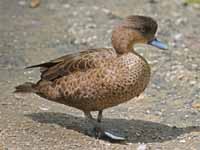
Teal,_Yellow-billed Anas flavirostris
Description: The Yellow-billed teal has a yellow bill with black center ridge and black tip. It has black and brown upperparts, The grey flanks are unspeckled and it has a grey belly. The grey breast is heavily spotted. It has a black speculum with a rufous leading edge and a white trailing edge. The similar Yellow-billed Pintail has spotted flanks,
Range: South America.
Habitat: Freshwater wetland during breeding season; brackish or saline coastal waters in winter.
Diet: Aquatic plants, insects, crustaceans, mollusks.
Conservation status: Least Concern.
Range: South America.
Habitat: Freshwater wetland during breeding season; brackish or saline coastal waters in winter.
Diet: Aquatic plants, insects, crustaceans, mollusks.
Conservation status: Least Concern.
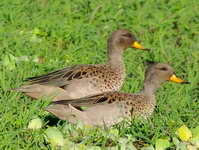
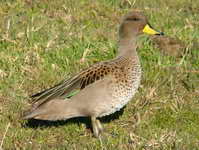
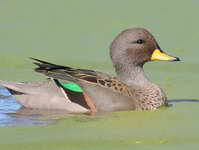
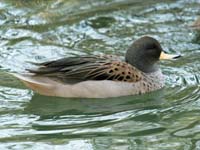
Genus Callonetta - 1 species
Teal,_Ringed Callonetta leucophrys
Description: The ringed teal has a green or turquoise speculum with a large white patch in front of it. The male has chestnut upperparts and a black stipe from the top of its head to the nape. Its pink breast is speckled with black and the belly is pale grey. The black under-tail has a white patch. The female has a brown back and face with a white supercilium.
Range: South America.
Habitat: Secluded freshwater wetlands.
Diet: Acquatic plants and aquatic invertebrates; also seeds.
Conservation status: Least Concern.
Image by: 1, 2, 3) Dick Daniels - Sylvan Heights 4) Dick - Washington National Zoo Range: South America.
Habitat: Secluded freshwater wetlands.
Diet: Acquatic plants and aquatic invertebrates; also seeds.
Conservation status: Least Concern.
1) Pair 2, 3) Female 4 - 6) Male

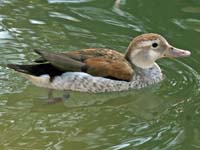
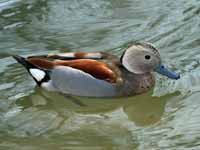
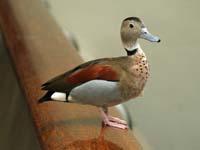
Genus Sibirionetta - 1 species
The Baikal tesl was formerly placed in genus Anas.
Teal,_Baikal Sibirionetta formosa
Description: The male Baikal teal has dark brown crown with a white supercilium passing above the eye and ending at the nape. The yellow face has a striking black swirl and there is also yellow on the front of neck. The breast is light brown with dark spots. The brown back has long scapulars and the sides are grey. It has a dark green speculum with red leading edge and white trailing edge. The female Baikal teal has a white spot at the base of its bill and the faint hint of a white supercilium. It has a brown back with short scapulars.
Range: Asia.
Habitat: Nests in freshwater wetlands with trees close by, also in Arctic tundra. Nonbreeding it may also be found in brackish water.
Diet: Aquatic plants and invertebrates. Also rice.
Conservation status: Least Concern.
Image by: 1) Ken 2) Tokumi 3) Sarefo 4) Dick Daniels - Sylvan HeightsRange: Asia.
Habitat: Nests in freshwater wetlands with trees close by, also in Arctic tundra. Nonbreeding it may also be found in brackish water.
Diet: Aquatic plants and invertebrates. Also rice.
Conservation status: Least Concern.
1) Juvenile male 2) Female 3, 4) Male
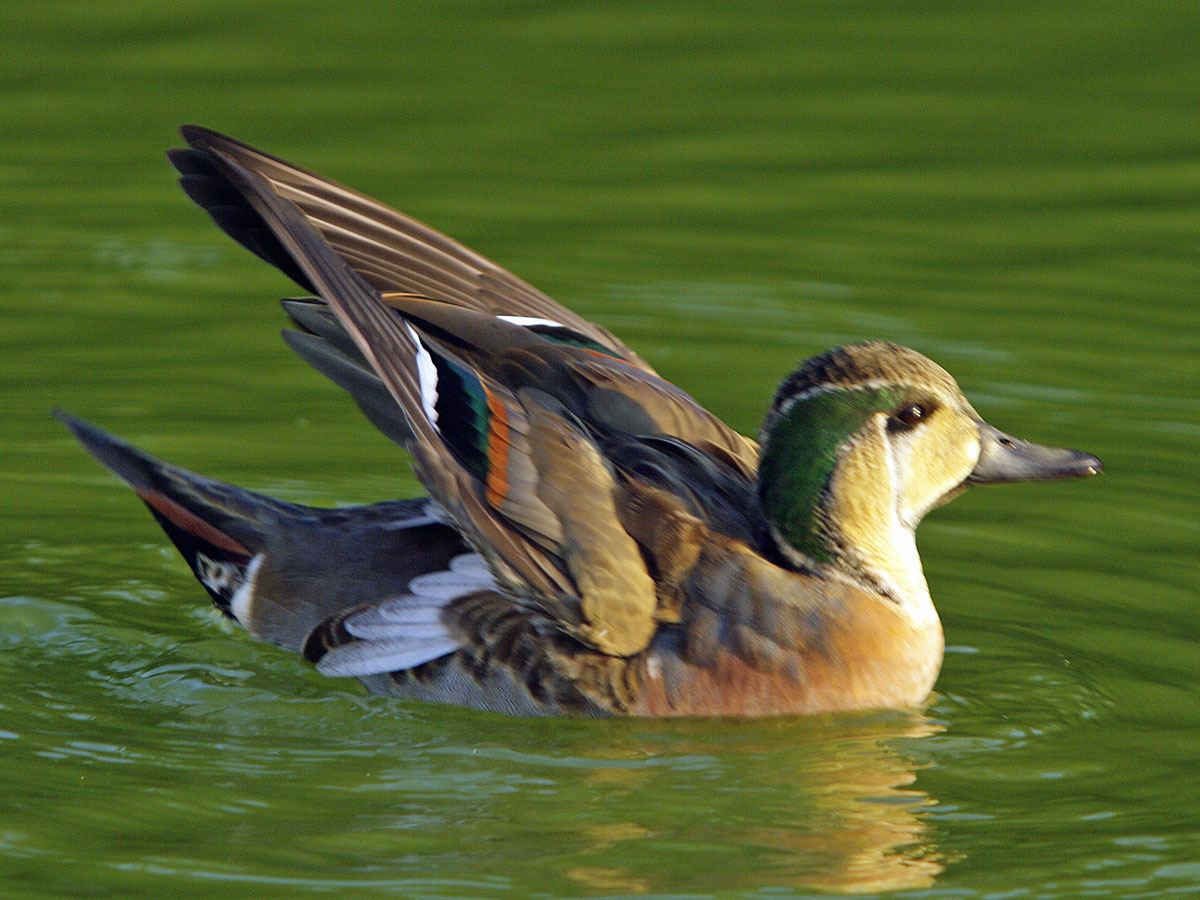
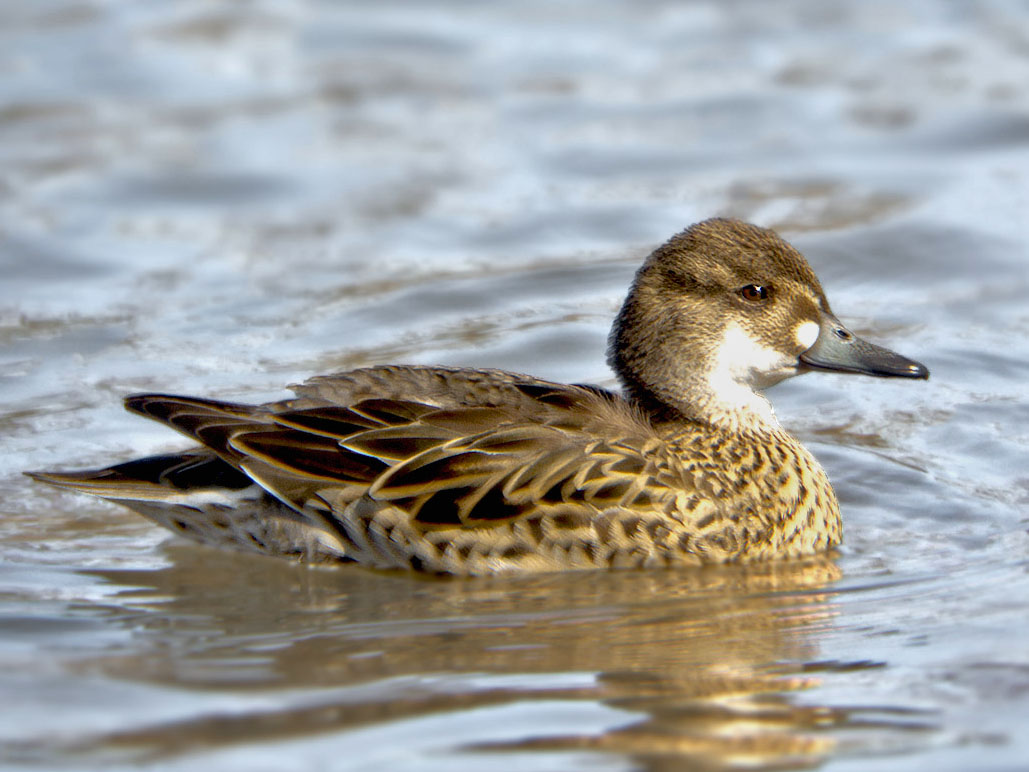
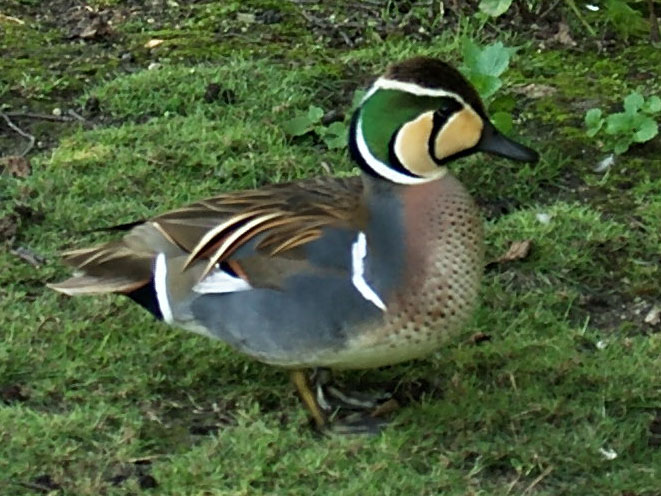

Genus Spatula
The shovelers have very long bills. Their wide-flat bill is equipped with small, comb-like structures on the edge of the bill that act like sieves, allowing the birds to skim crustaceans and plankton from the water's surface. Shown here are the members of Spatula that are teals. There are many other members of the genus that are not called teals.
Teal,_Blue-winged Spatula discors
Description: Breeding male has a greyish blue head with a white facial crescent, a light brown body with a white patch near the rear and a black tail. The adult female and nonbreeding male are mottled brown. They have a black eye-line that bisects a white eye-ring, and have a whitish area at the base of the bill. This whitish plumage on the female continues to the neck. Both sexes have vivid blue wing coverts and a green speculum. They have yellowish legs. The female and nonbreeding male blue-winged teals are similar to the cinnamon teals. The blue-wing teal's black eye-line is an identifying feature.
Range: The Americas.
Habitat: Freshwater wetlands with protruding vegetation. Also salt-marsh meadows with adjoining ponds or creeks.
Diet: Mainly aquatic vegetation. Also insect, mollusks, crustaceans.
Conservation status: Least Concern.
Image by: 1) Dick - Sanibel Island, Florida 3) Felix_Uribe 3) Dick - Sylvan Heights 4) Dan Pancamo - TexasRange: The Americas.
Habitat: Freshwater wetlands with protruding vegetation. Also salt-marsh meadows with adjoining ponds or creeks.
Diet: Mainly aquatic vegetation. Also insect, mollusks, crustaceans.
Conservation status: Least Concern.
1, 2) Male, female pair 3) Nonbreeding male 4, 5, 6) Breeding males
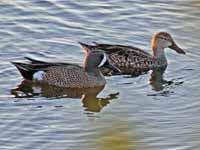
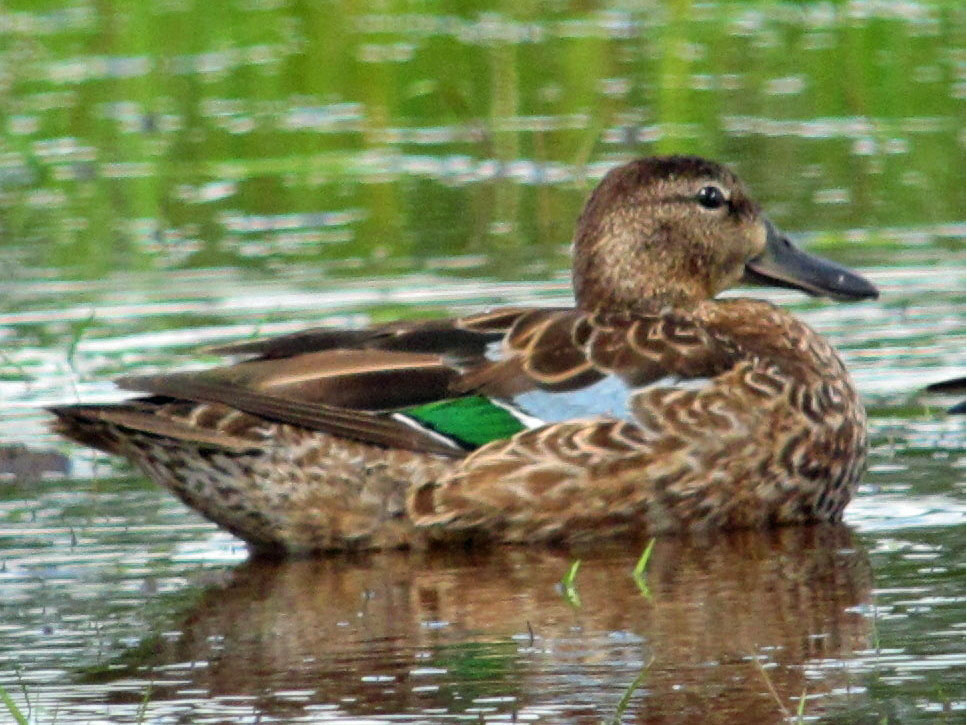
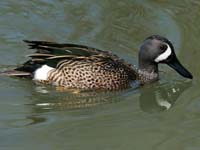
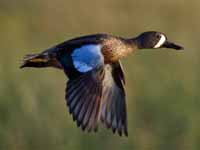
Teal,_Cinnamon Spatula cyanoptera
Description: The adult male has a dark cinnamon-red head and body with a brown back, red eyes and a dark bill. The adult female has a mottled brown body, a pale brown head, brown eyes, diffuse white eye-arcs, and a long grey bill. The nonbreeding male resembles the female, but with a reddish mottled body and red eyes. Both sexes have yellowish legs. The male cinnamon teal has a darker head than the similar red shoveler.
Range: The Americas.
Habitat: Freshwater wetlands, but not moving water.
Diet: Mainly aquatic vegetation; also insects, mollusks.
Conservation status: Least Concern.
Image by: 1) Linda Tanner 2) Maggie Smith 3, 4) Dick - Sylvan Heights Range: The Americas.
Habitat: Freshwater wetlands, but not moving water.
Diet: Mainly aquatic vegetation; also insects, mollusks.
Conservation status: Least Concern.
1) Pair 2) Female 3, 4) Male
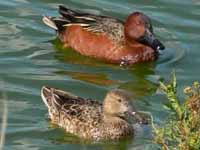
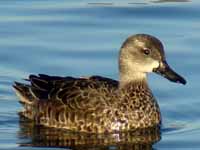

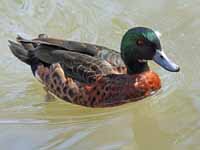
Teal,_Hottentot Spatula hottentota
Description: The small Hottentot teal, also know as the blue-billed teal, has brown upperparts and a dark head with a pale face. The breast has dark brown spots which become fewer on the belly. It has a blue bill with dark median line. There is an iridescent green speculum. The similar red-billed teal has a red bill versus a blue bill for the Hottentot teal.
Range: Africa.
Habitat: A wide variety of freshwater wetlands.
Diet: Aquatic vegetations, seeds, insects, mollusks, crustaceans.
Conservation status: Least Concern.
Image by: 1) Sandy Cole - Sylvan Heights 2) Derek Keats - South AfricaRange: Africa.
Habitat: A wide variety of freshwater wetlands.
Diet: Aquatic vegetations, seeds, insects, mollusks, crustaceans.
Conservation status: Least Concern.
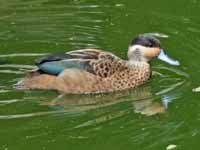
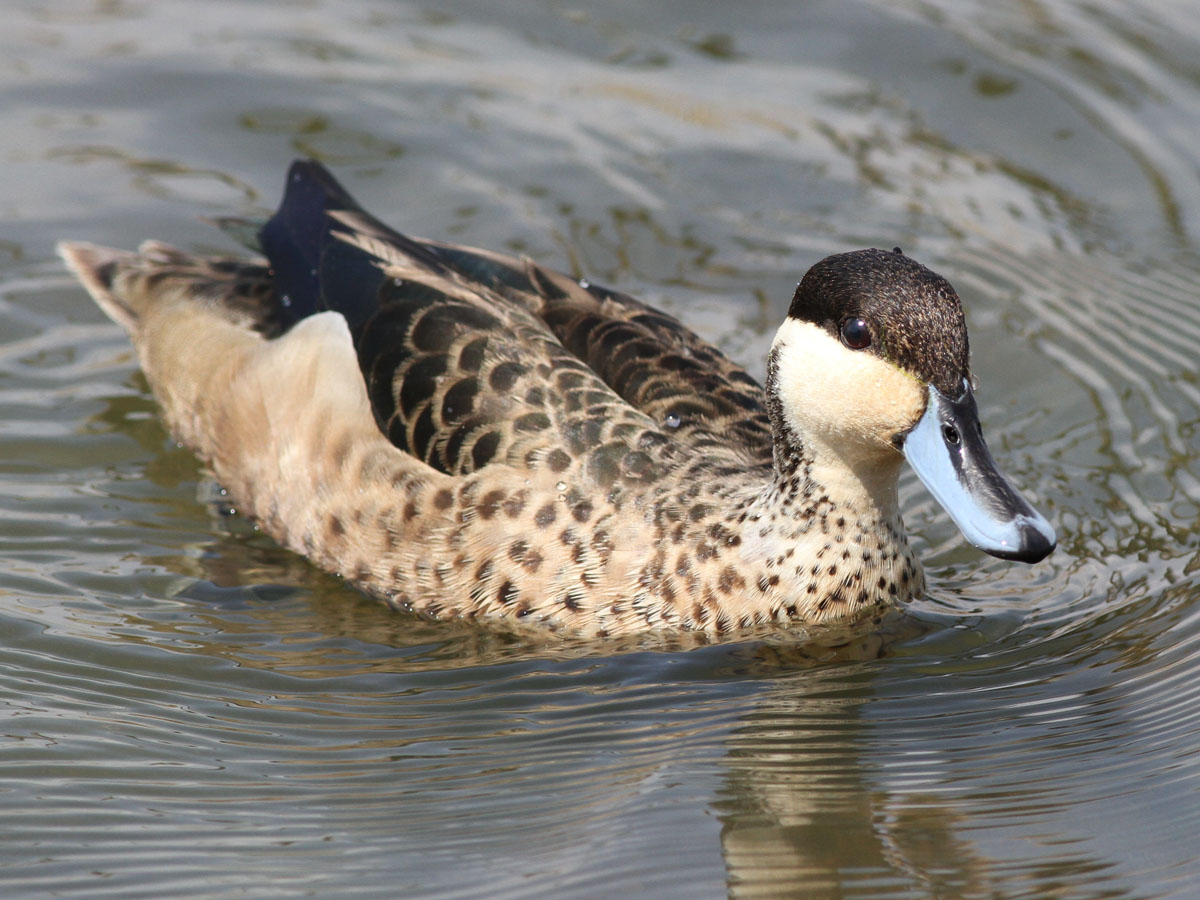
Teal,_Puna Spatula puna
Description: The Puna teal has a black cap that extends below the eyes and down the nape. The lower part of head is creamy as is the throat and upper neck. The lower neck is buff as is the breast which has dark brown spots. The bill is bluish with a black median stripe. It has a green speculum bordered with white. The Puna teal once was considered a subspecies of the silver teal. The can be differentiated by the yellow base of the silver teal's bill.
Range: South America (Peru, Bolivia, Chile, Argentina).
Habitat: Freshwater wetlands with floating vegetation.
Diet: Aquatic vegetation, insects, mollusks, crustaceans.
Conservation status: Least Concern.
Image by: 1, 2, 3) Dick Daniels - Sylvan Heights Range: South America (Peru, Bolivia, Chile, Argentina).
Habitat: Freshwater wetlands with floating vegetation.
Diet: Aquatic vegetation, insects, mollusks, crustaceans.
Conservation status: Least Concern.
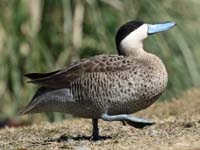

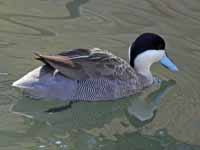
Teal,_Silver Spatula versicolor
Description: The silver teal has a silver rump. It has a black cap that extends below the eyes and down the nape. The lower part of head is creamy as is the throat and upper neck. The lower neck is buff as is the breast which also has dark brown spots. The bill is bluish with a black median stripe and yellow near the base. It has a green speculum bordered with white. The Puna teal once was considered a subspecies of the silver teal. The can be differentiated by the yellow base of the silver teal's bill.
Range: South America.
Habitat: Freshwater wetlands with shoreline vegetation.
Diet: Aquatic vegetation, insects, mollusks, crustaceans.
Conservation status: Least Concern.
Image by: 1, 2, 3 Dick Daniels - Sylvan Heights Range: South America.
Habitat: Freshwater wetlands with shoreline vegetation.
Diet: Aquatic vegetation, insects, mollusks, crustaceans.
Conservation status: Least Concern.
